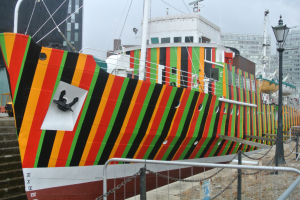In the event of a submarine attack, the safest place to be in Liverpool right now is on board the Dazzle Ship by Carlos Cruz-Diez. It presents a ‘moving’ target even when moored up.
Clashing colours and disruptive patterns were hit upon during World War One as a way of confusing German U-Boats who, after all, were visually handicapped by periscopes.
Dazzle paint was the invention of Norman Wilkinson who could therefore add the job title camoufleur to his CV along with marine painter, poster artist and illustrator.
The Navy bought into his theories in a big way and this dock in Liverpool, called Canning Graving, was during 1917-18 busy with Dazzle designs and painting crews.
Another artist employed with this war effort was Edward Wadsworth, a Vorticist, who was to make a number of Dazzle woodcuts and stick with maritime themes.
Venezuelan artist Cruz-Diez has found a new use for Dazzle camo: the appointment of a literal flagship for the Liverpool Biennial. It will delight as much as it will confuse.
But the full name of the piece is another obsfucation: Dazzle Ship: Induction Chromatique à Double Fréquence pour l’Edmund Gardner Ship.
Incidentally, the Edmund Gardner is a pilot ship built in 1953. Its peacetime role has been to provide a base for those who safely guide ships in and out of Liverpool.
But did I say ‘peacetime’? That’s an easy mistake to make. After all, dazzle is everywhere these days. It is the human cost of ongoing conflict we now strive to camouflage.
Cruz-Diez may be making a formal statement with his Induction Chromatique. But Dazzle Ship harks back to the moment abstraction and pure form got pressed into service by the real world.
Dazzle Ship can be seen at the Liverpool Biennial, until 26 October, and beyond until the end of 2015.
